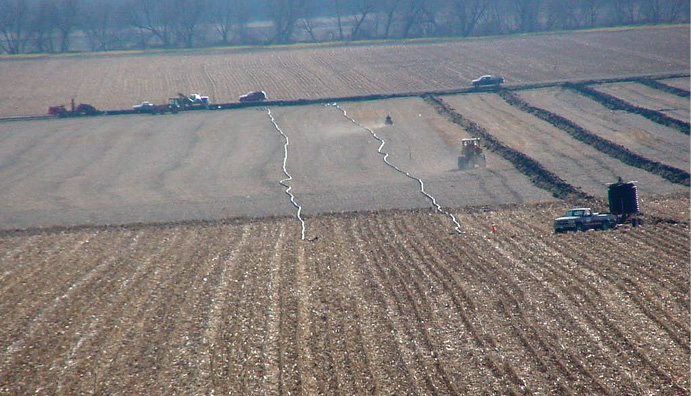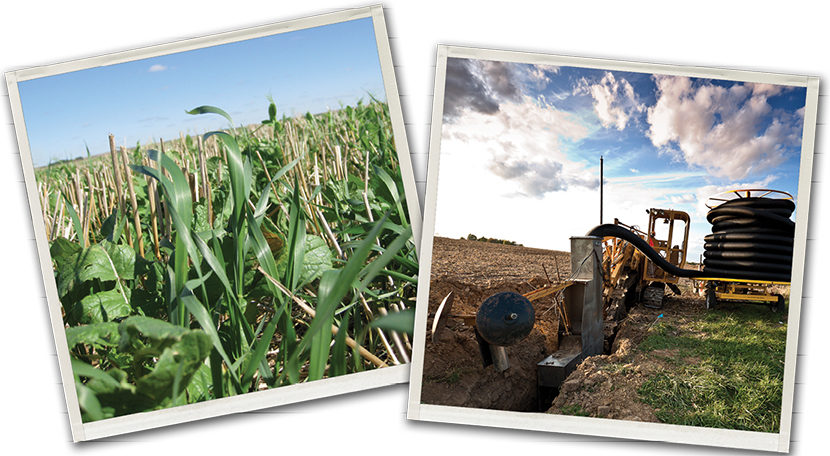With crop prices and farm incomes at record levels, many no-tillers have been pouring substantial sums of money into improving drainage.
The benefits of increased yields and timely field operations are well documented when poorly drained fields are tiled, and high commodity prices provide a quick return on investment. Some no-tillers see tiling as a wise way to reduce their taxable income.
But there’s a school of thought developing among some no-tillers that cover crops can, in some situations, do what is required to dry out their fields in the spring and avoid a $500- to $800-an-acre investment in tile lines.
So which approach is best? There’s no simple answer, but no-tillers and strip-tillers are encouraged to do the math on both systems and know to what degree your fields can be helped with either cover crops, tiles or both.
Getting Fields Ready
In recent years, Carroll, Ohio, no-tiller David Brandt has suggested that cover crops are his best option for draining fields, given his farm’s individual needs and circumstances.
Brandt, who no-tills about 2,000 acres split between corn, soybeans and winter wheat, says 90% of his farm ground is cash rent and not systemically tiled. Slopes in south-central Ohio average 6% to 10%, but can reach 20%.
Brandt estimates 70% of farmland in his area is owned by absentee landlords, a major disincentive for farmers to invest in tile because they might not have access to the field long enough to reap the benefits.
Between October 10 and November 20, Brandt hires someone to drill 25 to 30 pounds per acre of cereal rye on 350 acres of “really wet fields” going to soybeans. The rate is 40 to 50 pounds per acre if it’s being aerially applied.
Brandt will add oilseed radishes if the rye is being seeded early enough to provide 4 or 5 weeks of growth before frost occurs and the radishes winterkill.
In the spring, the cereal rye goes to work, growing rapidly and drawing up moisture from the soil as the snow melts and spring rains arrive.
“On days when it’s sunny and 60 or 70 degrees F, the cereal rye will remove moisture from about 1 inch of soil per day,” Brandt says. “I’ve found the radishes will penetrate the subsoil and water seems to move through the soil profile better than where we’ve not done anything.
“We’ve really seen field drainage improve using covers. Nothing will beat putting in systematic tiles, of course. But not owning property made me look to other resources to improve drainage. We look to deep-rooted cover crops to do that for us.”
Crunch The Numbers
Brandt says cereal rye seed costs him an average of $16 an acre, plus another $10 to $12 an acre in labor to drill the cover. It would be cheaper at $14 an acre to have the cover aerially applied if weather is cooperating, he says. It costs $6 an acre to terminate the cereal rye with glyphosate.
“The big thing you must be concerned with is the kind of spring you have,” Brandt says. “If you have an early, dry spring, in March or April, you may want to terminate the rye cover earlier so you don’t remove all the moisture.”
No-tillers should also consider that residue remaining on the soil surface after cover-crop termination increases water infiltration and may prevent moisture from evaporating, prolonging the drying period for the soil.
“A hard thing with cover crops is learning to manage what works for you,” Brandt says. “You can talk to six different people and get 35 different ideas on how to do it.”
A Case Study
This debate about cover crops vs. tile seems to have gained a foothold further west in South Dakota, North Dakota and Minnesota, where the number of tiling projects has seen a sharp increase.
Controversy is emerging over the environmental impact of tiles. Critics believe the systems are inundating waterways with runoff full of nutrients, sediment and other material.
A 2010 study of 153 watersheds by researchers at Cornell University and the University of Illinois alleged that highly productive, tiled fields in the Corn Belt were partly to blame for the large amount of nitrogen fertilizer draining into the Mississippi River and Gulf of Mexico.
But proponents of tiles respond that tile systems allow for more even drainage scenarios than allowing water to run off unfettered.

Christopher Hay, a water-management engineer for South Dakota State University Extension, says some farmers using cover crops in his state are satisfied with the moisture management they’re getting and question the need to install drainage systems.
So the university is beginning limited research of evapotranspiration (ET) rates of cover crops on a field near Andover, S.D., planted to a spring wheat, corn and soybean rotation.
Evapotranspiration is the sum of evaporation and plant transpiration from the land surface to the atmosphere. Evaporation accounts for the movement of water to the air from the soil, canopy interception and water bodies. Transpiration accounts for the movement of water within a plant and the subsequent loss of water as vapor through the stomata in its leaves.
The field is typically seeded with a mix of radishes, field peas and cereal rye after spring wheat, with the peas and radishes winterkilling and cereal rye terminated in the spring with glyphosate. Instruments installed on site recorded an ET rate last year of 1 to 5 millimeters per 24 hours, or 0.03 to 0.2 of an inch of moisture.
Hay doesn’t have a field nearby without cover crops to do a comparison. He’s looking for a larger area to continue the research and investigate options for using remote-sensing equipment to measure ET.
“We want to look at the whole water-balance issue in a cover-crop system vs. one without cover crops,” Hay says. “ET rates are an important part, but not the only part of that. With cover crops, we’ve got transpiration from the plants, and they also reduce evaporation and increase filtration because less water will run off. We want to figure out what the net result is.”
He notes the soils and climate in eastern South Dakota are in a “transition zone” that is very different from Ohio, Iowa and other Corn Belt states that see more annual rainfall. Soils with cover crops in this region tend to be where wheat is grown, because farmers have trouble getting a cover crop established after harvested corn or soybeans.
“Most folks are putting in targeted tile systems to go after wet spots in fields. Where they’re pattern tiling, we’re looking at drainage co-efficients of ¼ to of an inch per day — a little more than the maximum ET rate you’d get out of a cover crop,” Hay says.
“Both the cover crop and tile will change the water balance of the field, but in different ways. The true comparison, then, is what each of those means for wetness and traffic-ability in the spring. That’s a more difficult comparison to make, at least with what we know now.”
But Hay does have a rule of thumb for farmers evaluating whether cover crops or tile works best for their farm.
“I tend to tell folks that when you have drainage problems every other year to once every 5 years, if you can get past that problem with cover crops, it makes less economic sense to do tiling,” he says. “It’s probably in moderate cases with drainage issues where cover crops may eliminate the need to invest in drainage, or it can be complimentary.”

Tile’s Big Benefits
Even for the most ardent cover-crop advocate, it may be hard to argue against the benefits of pattern-tile systems, especially on farms with tight, poorly drained soils that tend to see heavy rainfall.
A 12-year research project by Ohio State University that included both no-till and conventionally tilled fields found tiling reduced erosion by 40%, phosphorus loss by 50% and potash loss by 30%.
The study found a 20- to 30-bushel-per-acre increase in corn and 7 to 15 bushels in soybeans for tiled fields.
Tiling advocates point to less plant stress, better stands and more timely field operations for tiled fields, especially in northern climates where soils take longer to dry out and warm up.
Bob and Monte Bottens have invested hundreds of thousands of dollars improving the water-absorption rate of their farm ground near Cambridge, Ill., to a point where it can hold a 2-inch rain without washing.
The Bottens have used a Trimble RTK system and tile plow to install pattern tile on nearly 1,000 acres at a cost of $200 to $250 an acre. They laid tile mains at 30-foot intervals in tighter soils and every 40 feet on higher-quality soils.
Bob says the savings realized from installing tile themselves paid for the cost of buying the plow, and the improved drainage is showing a yearly payoff.
“If you pattern-tile the worst spots in a field, tile will pay for itself in 1 year,” Bob says. “If you don’t have bad spots and you’re still doing a whole field, it may be a 6- to 8-year payback. And you also know that if a particular corner is dry, the whole field is dry.”
In corn, they’re seeing up to a 50-bushel-an-acre difference in fields where tile was installed compared to where it’s not. The difference with soybeans is harder to decipher.
“Since tiling, our soil tests show we don’t need as much phosphorus and potassium,” Bob says. “That says to me our nutrients aren’t washing away and that we get better use of fertilizer because the microorganisms make it more plant available.”
Keeping excess water out is also important to maintaining acceptable soil microbial activity. For example, Bottens Family Farm received 7 inches of rain in a 4-day period last spring, including 3 inches at one time.
Scenarios like this set the stage for nitrogen to leach from the soil profile and for compaction to form, and soil microbial activity could be hurt.
“I firmly believe that at any time there is total saturation over a 24-hour period in the topsoil, to a minimum of 1 foot, the microbes die off from lack of oxygen in the soil,” Bob says. “Put those things together and even in a normally dry year, there’s yield loss from the lack of tile.
“If we can minimize these factors, we can maximize our yields.”
The Bottenses don’t use cover crops, although they’re taking a serious look at what will work in their area. In comparison to covers, Bob notes that pattern tile doesn’t have recurring costs like seeding and termination of cover crops.
“I never have to worry about termination timing, and a potential major crop failure or setback potential once in 10 years,” Monte Bottens adds. “This is a risk cost that needs to be factored in when calculating and comparing.”
And there’s the issue of moisture removal from the soil. Bob thinks covers can remove plenty of moisture in a short period of time, but will it be too much in a dry year?
“Tile only takes away excess moisture,” Bob says. “Our pattern-tiled fields will only run for about 2 days after a rain event, then it’s just a trickle like what we used to see years ago all the time. That tells me it’s easier for the water to exit through the tile lines when there’s too much.
“Even after a significant rain of 2 or 3 inches, within 24 hours the water flow in the laterals is done, while the mains may carry a little trickle for a while.”
For naturally poorly drained soils, which usually have a 0% to 2% slope, cover crops and good soil structure will not replace the need for tile, says Eileen Kladivko, an agronomist with Purdue University.
“The natural water table is high, and the tiles are lowering that natural water table to the depth of the tile more quickly than if the tile wasn’t there,” Kladivko says. “Even for most soils that are naturally somewhat poorly drained, tile drainage is likely needed.”
“Either cover crops or tile, or both, are needed to stop erosion,” Monte adds. “Any erosion is the farmer’s fault and we have to take responsibility for it.”
Working Together
Even if cover crops aren’t a cheaper answer for investing in tile in most regions, there’s still a way covers can help no-tillers save money.
Deep-rooted cover crops will improve water-infiltration rates and help pattern-tile systems already in place work more efficiently
“As we’re using radishes with two or three other species, we’re seeing water infiltration get better, whether or not a field has tile,” Brandt says. “There’s a lot of talk about putting more tile in between existing lines. But if I could get no-tillers to grow a cover crop, it would loosen the soil and maybe they wouldn’t have to install more tile.

“We have areas above tile lines where it only takes 3 or 4 days for the soil to dry, and a week or even 10 to 15 days in spots that are further away from tile. If you have cover crops, there seems to be less drying time for fields because the water is moving through the root channels.”
“Let’s say it costs $800 per acre to split your tile lines on a 40-foot spacing,” says Ohio State University Extension educator Jim Hoorman. “Take the interest on that money — $800 per acre at 4% interest, or $32 per acre — and invest it in cover crops that decrease soil compaction.
“Water has difficulty flowing vertically or horizontally to tile lines in compacted soils with poor soil structure. Cover-crop roots and earthworms create macropores to move excess water quickly to your existing tile.
“Smaller roots create mesopores and micropores, where the movement of soil water slows down so soluble nutrients may be absorbed or retained.”
Some soils with slopes of 6% to 10% that may not be classified as poorly drained or somewhat poorly drained may have wet seepage areas or other factors making them wet, Kladivko says.
“So they may still need tiles in places, but the overall water table is not likely high for long periods of time,” she says. “Even where tiles are needed on those flat, poorly drained areas, it’s true that sometimes tiles don’t work as well because of compaction slowing the rate of water flow to tiles.
“Cover crops could improve infiltration and permeability, reduce compacted layers and help the tiles already there function better.”
“I had a farmer with a poorly drained field with no tile where he seeded oilseed radishes, hoping to improve drainage. But the radishes didn’t get very big and he still had a poorly drained soil,” Hoorman says. “He needed an outlet for the water — tile. Once you have a good outlet, cover-crop roots may help move the water to the tile to drain the field.
“Except for rice, most of our grain crops don’t grow well in standing water. If you improve the soil structure, the water may move within the soil profile, which will help with drainage.”
Cover crops, along with drainage ponds or wetlands, might also help keep expensive nutrients from flowing out of tile lines into waterways.
Ray Archuleta, a conservation agronomist for the USDA’s NRCS, demonstrated the factors affecting tile performance during the 2012 National No-Tillage Conference in St. Louis using straws, tall jars, soil samples and cups of water.
Soil coming from a conventionally tilled field with no cover crops produced more runoff to no-tilled, cover-cropped fields.
“Your tile drainage will not work unless you have healthy soil,” Archuleta says. “The pores have to be open from the top all the way down to the bottom. And the best thing to help your tile drainage is cover crops. They store the nutrients and help keep the pores open.”








Post a comment
Report Abusive Comment